Macau, China
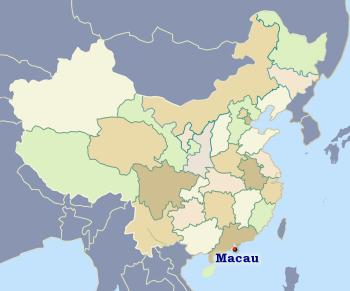
| Province | Ào mén 澳门 'bay entrance' |
| Short name | 澳 Ào |
| Capital | Macau City |
| Population | 0.683 million (0.05%) [33rd last] comparison table |
| Area | 1,000 km2 [386 mile2] (0.01%) [32nd] |
| GDP | 269,131 (0.73%) [2nd] |
| Neighbors | Guangdong Hong Kong |
| Others | or just click on the map |
Macau (or Macao) is a relic of China's subjugation by European powers. It was governed by Portugal for nearly 450 years. Macau stands on a rocky peninsular on the mouth of the Zhu (Pearl) River estuary connected by bridges to Taipa and Coloane Islands .
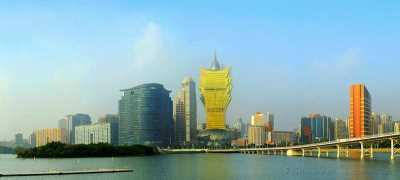
Like Hong Kong it has fifty years of semi-autonomy (’one country, two systems’) within China before it becomes fully assimilated. Portugal never had military conflict with China and so Macau has remained an example of foreign and Chinese living and working side-by-side. It has its own currency the pataca ➚ which is currently pegged to the Hong Kong dollar. Macau has a tiny area of only 11 sq miles [28 sq kms] with the highest population density in the world. A transport link over the Pearl Estuary to Hong Kong opened in late 2018. It is the world's longest sea bridge and part tunnel under the busy shipping lanes.
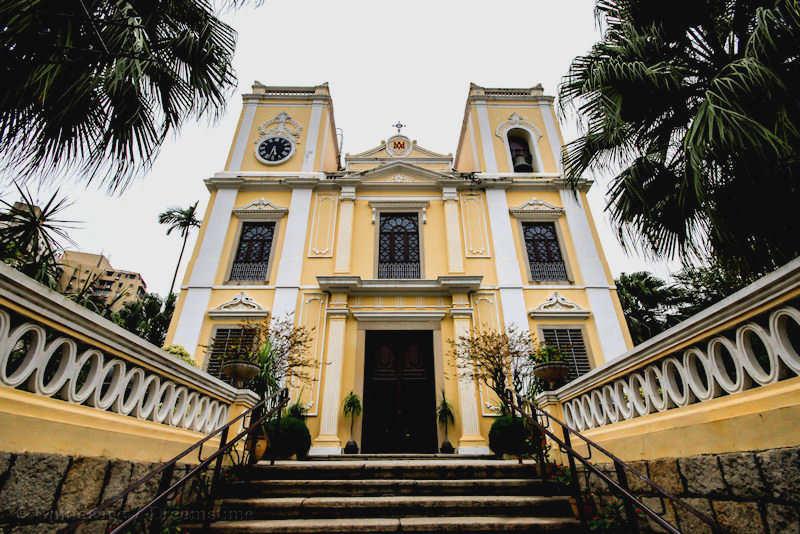
Places to Visit in Macau
The Portuguese gave it the name 'Macau' probably after a temple to Mazu a deity of the seafarers in the area. A Ming temple dedicated to her, also known as A-Ma Gau Temple, is located in the south west of the main island. The International airport has been built on an artificial island due to the scarcity of land. On Taipa Island there is a popular horse racing course . The Fortaleza do Monte ➚ on the central high part of the island has a museum documenting the outpost's history, while the ‘Largo do Senado’, at the old heart of the city, has many colonial style buildings. Many of the oldest buildings are of the Portuguese style even though they now represent only 2% of the population. More Portuguese style buildings are dotted along the Praia Grande. The ruins of St. Paul's cathedral, originally built by the Portuguese in baroque style in 1580 is the island's most famous landmark. The cathedral was the center of Jesuit teaching in the region and at one time the largest catholic church in Asia. There is an old protestant cemetery containing the gravestones of many Britons who succumbed to disease while trading with China. Macau Tower at 1,107 feet [337 meters] offers dizzying view of the whole area.
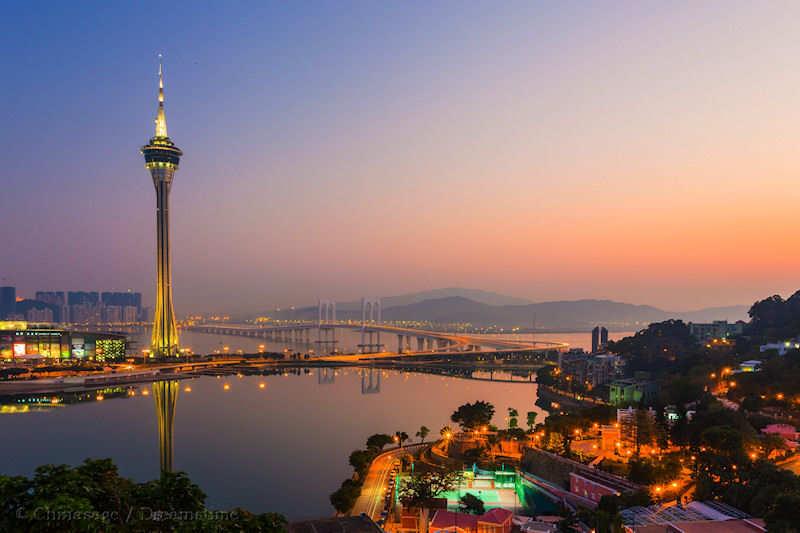
Macau's main industries continue to be tourism and gambling. With major casinos like Sands Casino ➚; Casino Lisboa ➚ and Venetian Macao ➚ (the largest in the World), it generates more gambling revenue than Las Vegas ➚. The traditional cuisine of Macau has a Portuguese style using olive oil, almonds and saffron. A very cosmopolitan mix of other cuisines is available, with seafood a major constituent.
Macau History
Macau is a Special Administrative Region (SAR) rather than a province like nearby Hong Kong on the other side of the Pearl river estuary. The mandarin Chinese name for the island is ‘Aomen’ meaning 'estuary entrance'. Both Cantonese and Portuguese are widely spoken in the city. Back in 1557 Portugal helped China remove Japanese pirates who were damaging trade to the port of Guangzhou (Canton). Portuguese traders then settled in the 16th century and it remained under the control of Portugal until December 20th 1999, making it the first and last foreign presence in China.
The early trade was extremely lucrative, the Portuguese acted as the trusted middlemen for trade between China and Japan. Then came a ban on direct trade between China and the ‘barbarous’ Japanese and so the Portuguese had a monopoly of the trade in luxury goods such as silk which they bought with Japanese silver. Because gold in China was relatively undervalued they could make huge profits by exchanging silver for gold and shipping the gold back to Europe. This lucrative trade came to an end when all contact with Europeans was banned by the Japanese Emperor at the end of the 1630s. However trade back to Europe continued via the spice islands and the Cape of Good Hope.
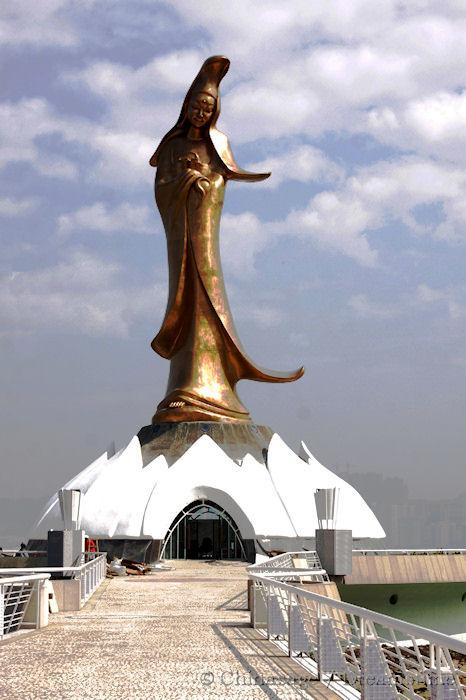
In the Qing dynasty up to the time of the Opium Wars foreign merchant ships were not allowed into Guangzhou for much of the year, and so the European crews spent several months at Macau. From the mid 18th century up until 1876 Macau was the center of the infamous ‘coolie trade’ where Chinese workers were treated no better than slaves. They were held in ‘barracoons ➚’ at Macau while awaiting transport to Cuba, Peru and other foreign destinations. Portugal's neutrality in the second World War made it a refuge for 600,000 fleeing the Japanese occupation from the Chinese mainland. Later on in the 1950s, when China was closed to International trade Macau became the conduit for many illicit deals. In the 1980s it began a period of rapid development but was far out-stripped by Hong Kong. A certain degree of democracy was introduced to the island in 1976.
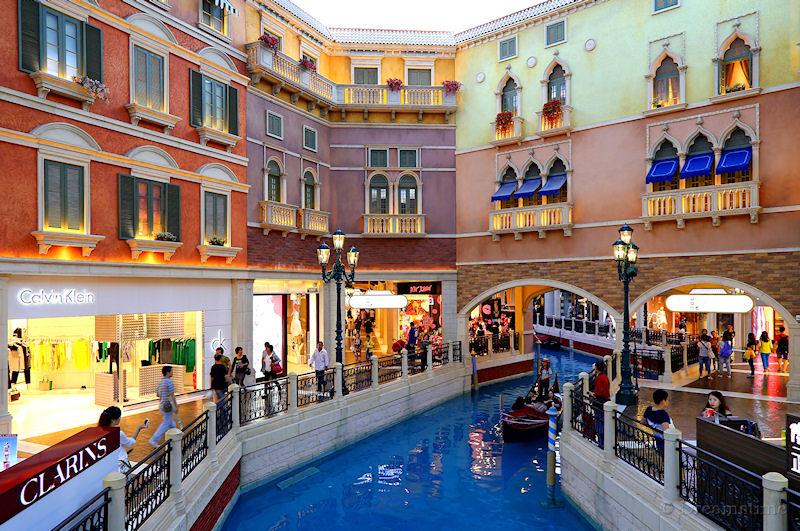
Macau has a warm and humid climate through most of the year. It can be very wet during the summer months.
Airports
The airport has 1 terminal and is located 2.5 miles (4.0 kms) from Macau City. Live Flight information ➚, Airport information ➚, rank in China 41
See map of location Macau International Airport

Google map of Macau
Bing map of Macau ➚
Show Bing Map ➚
Macau Climate
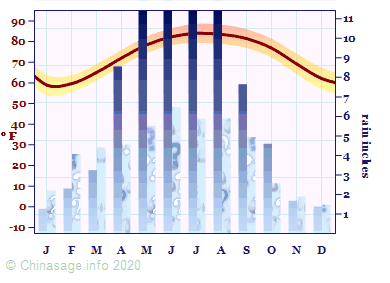
| Major Cities | Population | |
|---|---|---|
| Macau City | 澳门 | 650,900 |
Book: A Map History of Modern China: Catchpole: Heinemann: 1976 p. 14
Book: China : Eyewitness Travel: Dorling Kindersley: 2012 pp. 326-329
Book: China A to Z: May-lee Chai and Winberg Chai: Plume: 2007 pp. 161-162
Book: Modern China: A companion to a rising power: Graham Hutchings:… pp. 288-292
Book: Nagel's Encyclopedia guide: China: Nagel: 1978 p. 1203
Book: Symbols of China: Feng Jicai: Compendium: 2010 p. 124
Web page: Book: The Encyclopedia Sinica:Samuel Collins: Oxford University Press: 1917 ➚ p. 133
Web page: Macau (books) ➚
Web page: Macau (wikitravel) ➚
Web page: Macau Travel ➚
Web page: Macau Travel Guide: Facts: City Map: Tips: Entertainment ➚
City populations for 2012, Province statistics National Bureau of Statistics 2014